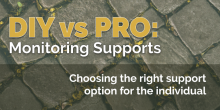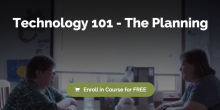
The Planning
Conversations surrounding technology supports have taken place between families and self-advocates, providers, and case managers. During these initial conversations, the goals, safety, security, independence level, and overall lifestyle desire of the individual were all taken into consideration.
What's Next?
The next step toward utilizing technology supports is creating a plan to formally explore and assess available options and establish an agreed upon approach. Now that the team has identified the goals and needs of the individual, it is time to choose the technology solutions to fulfill their care plan. This may include identifying potential technology sources, getting answers to more specific questions, assessing roadblocks, getting approvals, and lining up services.
Select below to begin planning from the perspective that matches your interests.

Providers
Explore technology support options to help serve clients and extend staff reach.

Family & Self-Advocates
Start a formal exploration of technology with case managers and providers to evaluate support options.

Case Managers
Work with self-advocates, family, and providers to identify lifestyle goals and explore technology solutions.










